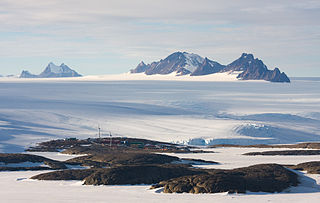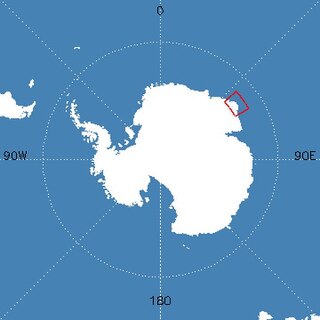Related Research Articles

Mawson Station, commonly called Mawson, is one of three permanent bases and research outposts in Antarctica managed by the Australian Antarctic Division (AAD). Mawson lies in Holme Bay in Mac. Robertson Land, East Antarctica in the Australian Antarctic Territory, a territory claimed by Australia. Established in 1954, Mawson is Australia's oldest Antarctic station and the oldest continuously inhabited Antarctic station south of the Antarctic Circle. It houses approximately 20 personnel over winter and up to 53 in summer.

The Prince Charles Mountains are a major group of mountains in Mac. Robertson Land in Antarctica, including the Athos Range, the Porthos Range, and the Aramis Range. The highest peak is Mount Menzies, with a height of 3,228 m (10,591 ft). Other prominent peaks are Mount Izabelle and Mount Stinear. These mountains, together with other scattered peaks, form an arc about 420 km (260 mi) long, extending from the vicinity of Mount Starlight in the north to Goodspeed Nunataks in the south.
The Scott Mountains are a large number of isolated peaks lying south of Amundsen Bay in Enderby Land of East Antarctica, Antarctica. Discovered on 13 January 1930 by the British Australian New Zealand Antarctic Research Expedition (BANZARE) under Sir Douglas Mawson. He named the feature Scott Range after Captain Robert Falcon Scott, Royal Navy. The term mountains is considered more appropriate because of the isolation of its individual features.

Mount Elkins, also known as Jökelen is a dark, steep-sided mountain with three major peaks, the highest 2,300 meters (7,500 ft) above sea level, in the Napier Mountains of Enderby Land. Enderby Land is part of East Antarctica, and is claimed by Australia as part of the Australian Antarctic Territory. The mountain was named after Terence James Elkins, an ionospheric physicist with the Australian National Antarctic Research Expeditions at Mawson Station in 1960.
Newman Nunataks
Sydney Lorrimar Kirkby, is an Australian surveyor and Antarctic explorer.
Kirkby Glacier is a glacier, 20 miles (30 km) in length. This glacier drains the central Anare Mountains of Antarctica and flows northwest to the sea 3 miles (5 km) from Cape North, and just north of Arthurson Bluff, northern Victoria Land. Richardson Bluff rises from its east side.
Kirkby Shoal is a small shoal area with depths of less than 10 fathoms (18 m) extending about 150 yards (140 m) westwards and south-southwestwards, about 3.4 km (2.1 mi) from the summit of Shirley Island, Windmill Islands, and 0.15 mi (0.24 km) northwest of Stonehocker Point, Clark Peninsula.
The Porthos Range is the second range south in the Prince Charles Mountains of Antarctica, extending for about 30 miles in an east-to-west direction between Scylla Glacier and Charybdis Glacier. First visited in December 1956 by the Australian National Antarctic Research Expeditions (ANARE) southern party under W.G. Bewsher (1956-57) and named after Porthos, a character in Alexandre Dumas, père's novel The Three Musketeers, the most popular book read on the southern journey.
Rippon Glacier is a small glacier located in Kemp Land, East Antarctica. It is close east of Seaton Glacier, flowing southward into Edward VIII Ice Shelf.
Mount King is a large, smooth-crested mountain in the eastern extremity of the Tula Mountains. Part of the Australian Antarctic Gazetteer and the SCAR Composite Gazetteer of Antarctica, it is located in Enderby Land, East Antarctica, which is claimed by Australia as part of the Australian Antarctic Territory. The head of Beaver Glacier is located very close to the base of Mount King.
Wilma Glacier is the western of two glaciers entering the southern part of Edward VIII Ice Shelf in Kemp Land, East Antarctica. The second, eastern glacier is Robert Glacier.

Armstrong Peak is a peak, 1,470 metres (4,820 ft) high, standing 15 nautical miles (28 km) southeast of Mount Codrington in Enderby Land of East Antarctica.
On the continent of Antarctica, the Aramis Range is the third range south in the Prince Charles Mountains, situated 11 miles southeast of the Porthos Range and extending for about 30 miles in a southwest–northeast direction. It was first visited in January 1957 by Australian National Antarctic Research Expeditions (ANARE) southern party led by W.G. Bewsher, who named it for a character in Alexandre Dumas' novel The Three Musketeers, the most popular book read on the southern journey.
Wattle Island is a small island lying close to the coast and 6 nautical miles (11 km) east of Kirkby Head, Enderby Land. Plotted from air photos taken from ANARE aircraft in 1956. Wattle is the vernacular name given to over 400 species of Acacia found in different parts of Australia.
Felton Head is a flat-topped, dark brown headland with a sheer seaward side, standing 3.5 nautical miles (6 km) east of Harrop Island on the coast of Enderby Land, Antarctica. It was plotted from air photos taken by the Australian National Antarctic Research Expeditions in 1956, and was named for Sergeant Kevin Felton, Royal Australian Air Force, an engine fitter at Mawson Station in 1960.
The McLeod Nunataks are an isolated group of nunataks 35 nautical miles (65 km) southeast of the Tula Mountains in Enderby Land, Antarctica. They were photographed in 1956 by Australian National Antarctic Research Expeditions (ANARE) aircraft, and were first visited in December 1958 by an ANARE dog-sledge party, with the position fixed by G.A. Knuckey. The group was named by the Antarctic Names Committee of Australia for I.R. McLeod, a geologist at Mawson Station in 1958, and a member of the ANARE dog-sledge party.
Single Island is a high ice-covered island on the west side of the Amery Ice Shelf about 26 kilometres (14 nmi) south of Landon Promontory. First plotted by ANARE from air photos taken in 1956, but incorrectly shown as a promontory. Later mapped by ANARE as an island. Named by Antarctic Names Committee of Australia (ANCA) for M. Single, senior diesel mechanic at Mawson Station in 1962, a member of the ANARE field party which visited the area in December 1962.
Mount Arthur is a mountain, 1,290 m, just west of Mount Douglas at the west end of the Scott Mountains, Enderby Land in Antarctica. Plotted from air photos taken from ANARE aircraft in 1956. Named by Antarctic Names Committee of Australia (ANCA) for J. Arthur, electrical fitter at Mawson station in 1960.
References
- 1 2 "Kirkby Head". Geographic Names Information System . United States Geological Survey, United States Department of the Interior . Retrieved 3 May 2013.
